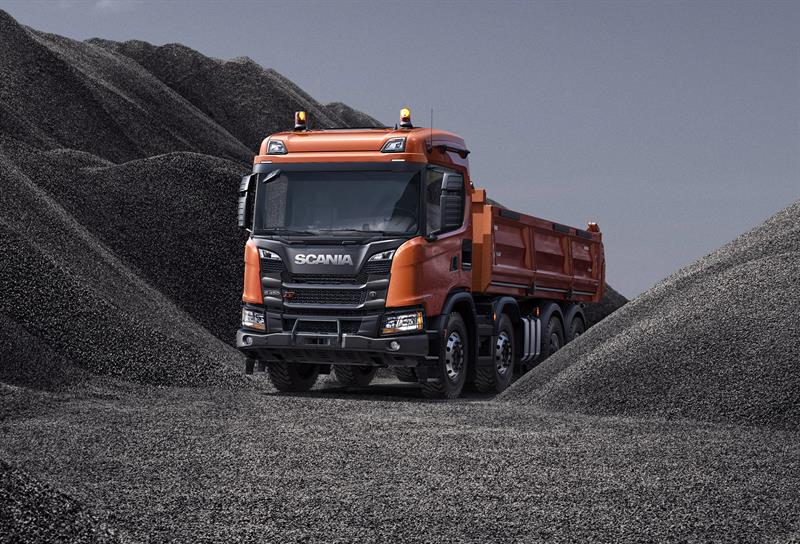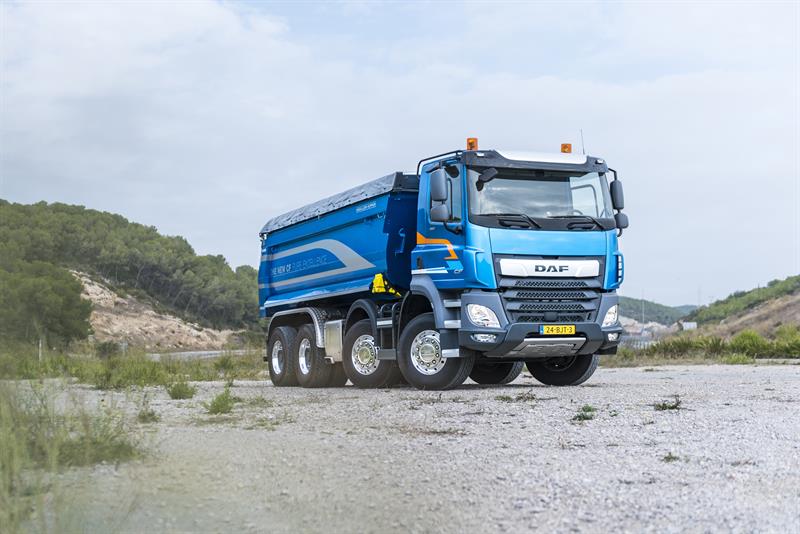Not that long ago managers of tipper, mixer and allied fleets had but a few basic, and usually overweight, chassis to choose from. One truck was pressed into many roles with a ‘hammer-to-fit‘ approach. Volvo was the first to step outside the mould with the introduction of its FMX. That was in 2010; recently, three others have followed.
First, my test drives of the Scania XT range, on- and off-highway, showed off the impressive range and variety of the trucks. Instead of just a few multi-wheelers, the XT treatment addresses all one might expect for vehicles operating off-road and on-site, as well as plenty of on-highway duty, too. Axles, frames, suspensions and the necessary utilitarian edges are all there, as well as 19 variants of its four-cab families. Engines? Take your pick from 11; the options available defeat the idea of a standard spec.

To illustrate, the range will include a 4x2 18-tonner with a low-roof, short P cab and a 9-litre, 275bhp engine, through three- and four-axle rigids, up to an 8x4 R730 heavy haulage tractor with a highline S cabin. The new P cab, launched at a late 2017 Södertälje, Sweden event and intended for construction, and urban and regional operations, has been a big beneficiary from the R&D spend further up the line; it has inherited improvements in everything from dashboard design and switches to materials upgrades.
The Opticruise 12+2 speed transmission gets an extra device that may just prise the last of the fingers away from the manual gearbox. ‘Clutch-on-demand’ is now an option that adds a clutch pedal that can be used in the normal way. The heavy haulage fraternity – those of them who are still running full manual boxes – would do well to have a look at it, as it addresses the last criticism we still hear, that of manoeuvring control on poor surfaces. Also new is an electronic handbrake that is pressure sensitive, answering the all-or-nothing complaint levelled at the standard electronic version. It is also activated if the driver's door is opened, or their seatbelt released, for extra safety on site.
Hill hold has been modified, too. When the electronic parking brake’s autohold position is chosen, instead of the three-second delay before release, there is now no time limit on how long it will hold the truck. It is also automatically reapplied when the truck stops again, such as in traffic queues.
Analysing where energy losses go in a truck, and mitigating them, is a science that can bring big rewards. Scania’s Anders Jensen, technical manager, energy optimisation, has 30 years of experience with the company in drivetrain development. At the XT launch, he spoke about the importance of the duty cycle. He said: “The demand on a vehicle will vary depending on the work it does, so the savings are not always found in the same place. And the construction sector is a tricky one, with so many different roles to cater for.” Accepting that energy losses are part of operating any truck, he says that just three criteria – aerodynamics, rolling resistance and brakes – have wildly different impacts in different operational sectors.
For example, a long-haul tractor’s energy losses in moving air and fighting rolling resistance amount to 60% of the total, with brakes accounting for 14%. The typical construction vehicle’s losses in shifting air and rolling resistance are down to 39% – a big difference – but with brakes climbing to 32%. Understanding these differences helps prioritise development strategy, he says.
DAF CF RIGIDS
DAF has also been fighting the fuel-efficiency battle on multiple fronts. When DAF showed off the underpinning engineering for its most recent upgrades at the CV Show in April, the company claimed a 7% fuel saving over previous models, thanks to extensive modifications to most aspects of the XF and CF. The company finished off the model launch with CF eight-wheeled rigids at a Barcelona launch event late last year. There, chief engineer Ron Borsboom said that the 7% saving prediction is being borne out in European operations, taking into account that it is only an average over its range of axle configurations. For example, the figure for a CF FAD 8x4 is 5%. (A CF 480 FAD 8x4 is pictured below). 
Progressive weight reductions, in this model and across the range, are clearly all helping toward fuel economy. For example, CF rigid chassis have slimmed down, too, with a chunky 285kg falling off that FAD 8x4. The aftertreatment system common to all XF and CF models is now smaller and 50kg lighter. The ZF TraXon gearbox is much improved, says Borsboom, with early versions being too heavy, in his view.
At a product launch event in Barcelona, I sampled the CF 480 FAD 8x4 tipper. DAF’s CF is already up against Volvo’s FMX and Scania’s new XT. But it performed well on the urban route out of Barcelona. And up a long grade, the MX13 was the right engine choice at 32 tonnes. The MX engine brake (compression release) alone was adequate, but we had been spoiled by an XF 530 with the added bite of a ZF intarder.
They both offer three-stage operation, but if the intarder is fitted, it delivers 33% at stage one by intarder alone, boosting that to 66% on stage two. The third stage adds the full effect of the MX engine brake as well. An MX engine brake, working alone, will simply deliver its effect in three equal stages. The decision to fit an intarder, or not, will be based partly on local topography and duty cycle, but the savings on friction materials on any work may be justification enough.
Speaking of drivelines, the TraXon’s ECU now also contains multiple ‘maps’ for different operations and duty cycles. The availability of these ‘multi-driving modes’ includes off road, long haul, liquid transport and heavy haulage.
I am increasingly finding that driveline software is able to add multiple ‘personalities‘ to vehicles and increase their flexibility for multi-role fleets.
Borsboom added: “The software is like the conductor of an orchestra in this environment. It will be even more important in the future, moving from a ‘nice-to-have’ to an essential component of economic operations.” Some of these advances were visible on the road. I noticed on test drives that Eco-Roll takes every possible opportunity to coast, sometimes for very short distances.
Two additions to the truck that I liked – sadly both only optional – were the battery status display and tyre pressure monitoring. Any workshop service manager will tell you that batteries are one of the most abused components, and flat ones stubbornly remain at the top of the list on winter call-outs. An early flag on a suffering battery could save the cost of a roadside repair and the delays that come with it. The same goes for tyres: they probably vie for that ‘most abused‘ badge, but a tyre out of scope on pressures is silently throwing away some of Borsboom’s 7%.
IVECO X-WAY
IVECO takes a similar approach to Scania, offering for its Stralis X-Way construction rigid a range of cabs, chassis layouts and thicknesses, hub and single reduction axles, three engine displacements at 9l, 11l and 13l, options on steel suspensions – and air, too – with a range of day and sleeper cabs to boot. On today’s automotive production line, almost infinite variety is becoming possible, and it is to great customer benefit – no more compromises.
At IVECO’s Magirus plant in Ulm, Germany, I took out a pair of four-axle rigid chassis. I was deliberately choosing bodywork with a high centre of gravity: an 8x4 with a Stetter Eco Light mixer drum, and an 8x2/2 flatbed with a Pastore chassis-mounted crane. On narrow rural roads, stability was good, but I much preferred the ride of the air-suspended 8x2 to the steel on the mixer. That was a lightweight two-leaf parabolic arrangement, part of a weight reduction package that included a hub reduction tandem axle bogie from FPT, 6.7mm chassis rails (down from the standard 7.7mm), the AD day cab with low roof, and the Cursor 9 engine.
The number of axles on these two vehicles was all they really had in common, and it underscored the options that are now on the table. To help operators choose the right model, IVECO has labelled its X-Way ranges as ‘ON’, ‘ON+’ and ‘OFF’. It says that the ON set-up features all the Stralis on-road characteristics of visibility and cab access, now available on multi-axle versions; the OFF set-up matches all of the high-mobility performance elements needed to fully comply with off-road homologation. ON+ is an intermediate set-up.
The new Hi-Tronix 12-speed AMT (a badged version of the ZF TraXon) performed very well in both of these rigids, but the star of the show was the six-stage retarder and engine brake. On the lively topography of the X-Way test route it came into its own. The mixer had only the standard CR (compression release) engine brake, and we sorely missed the retarder. The 8x2 had it fitted, and the additional confidence it gave was impressive.
One last device is worth a mention: the Hi-Traction hydrostatic drive that can be specified on the front axle of some X-Way chassis, including tractors. (Similar systems are offered on Renault and Mercedes-Benz trucks, at least.) It certainly works. A light 4x2 tractor driven by a fellow journalist was struggling for traction on a quarry incline (not its usual habitat), and the extra drive on the front end retrieved its headway.
However, I remain unconvinced. An extra 400kg of complex pipework and hydraulic pumping equipment firing into wheel hub motors looks likely to suffer from maintenance issues down the line. Given its oddball nature, it also poses a question mark over resale value for used buyers. Considering the cost, weight and uncertain future value, I’d invest instead in some training that would hopefully prevent a driver putting a single-drive vehicle in that position in the first place.
BOX: HIAB’S 18-TONNE SKIPLOADER COMPLETES MULTILIFT FUTURA LINE-UP
In other construction vehicle news, Hiab has launched the Multilift Futura 18 skiploader, completing the Futura line-up offering payloads of 8, 12 and now 18 tonnes.
The truck’s construction, using EvoLight steel, enables payload to be maximised while retaining strength, says the company.
“We also paid a lot of attention in our R&D to easy service and maintenance to maximise our customers’ uptime. The key components are easy to access and conduct in routine inspections,” says Pauliina Kunvik, Hiab’s director of product portfolio management for demountables.
Safety options match the other Futura models and include hydraulic side stops, hydraulic container lock and controls, and safety interlocks.